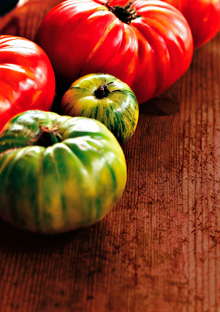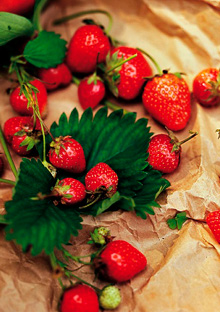
Photo: Jim Franco
Welcome to chef Michel Nischan's garden, where fresh-picked herbs and crunchy vegetables wind up in spectacular dishes: basil-flecked chicken, lemon pepper ribs, and (thank you, cardamom) the best strawberry shortcake you've ever tasted.
Michel Nischan's Fresh-from-the-Garden Menu
Visit the Nischans and you might wonder, "Where do these people come from?" On what planet do 15-year-olds exclaim over the deliciousness of Mom's cauliflower and 17-year-olds voluntarily change a baby brother's diaper? In the idyllically named town of Fairfield, Connecticut, this family of seven comes dangerously close to being too good to be true. Lori Nischan, the mother of the brood, wears high heels when a reporter comes calling, then vamps facetiously that of course she wears them all the time. Incapable of putting on airs, these Norman Rockwell people seem both otherworldly and down-to-earth. Earth as in dirt.Michel Nischan's Fresh-from-the-Garden Menu
The Nischans are suburban farmers. Or overactive gardeners. Either way, they're conducting an unusual domestic experiment, the results of which, they hope, will someday be replicated on thousands, or millions, of plots across the land: They're trying to feed themselves by themselves. It's a goal with a vanishing point; even with scores of vegetables and herbs being cultivated and with plans for a root cellar, pickling, canning, and preserving, they don't expect to grow absolutely everything they eat, or to adopt, say, a family cow. The third-of-an-acre farm isn't a puritanical test of their endurance but a family project, something to rally around.
For Michel Nischan—dad of the house, author of the James Beard Award–winning cookbook Taste Pure and Simple, and longtime chef (who isn't French, despite his first name)—the impetus behind what he calls "the whole grand thing" came, like virtually every aspect of his culinary life, from his late mother. She was the original farmer in the burbs. "Where other families would have bushes and flowers, we had vegetables," he says. "Every square inch of our subdivision yard in Des Plaines, Illinois, was cultivated." While his mother's crops were in rigorously straight rows, the Nischans' field has winding curves, each section bordered by tall half-logs. Lori Nischan has ensured that the family isn't overrun by squash, peas, and beets by mixing in flowers, lanterns, chairs, birdhouses, and more than a few iron roosters. Just outside the main vegetable garden, they've planted a teardrop-shaped bed of red, white, and blue flowers as a memorial to fallen soldiers.

Photo: Jim Franco
"My mom made me work in the garden, she taught me how to cook, and she built relationships with neighbors, policemen, firemen—the whole community," Michel Nischan says. "She used food as a metaphor for so many things in life. When I looked at my career, after being a chef for 20 years and cooking for other people till midnight, it hit me that I hadn't done anything for my children—other than love them and provide for them—that would influence their lives the way my mom did mine. I saw the garden as a chance to be involved with them, to deal with successes and failures, and then to come together in the kitchen to prepare the food."
As you might expect, watermelon, arugula, and toasted-almond salad tastes better when you've had a hand in producing the watermelon and arugula. Similarly, basil chicken with grilled kale and heirloom tomatoes gives an extra kick when it's made with genuine family heirlooms. The surreal part is that the Nischans' five kids actually buy into all this. Although pruning 11 kinds of lettuce isn't their 19-year-old daughter's idea of fun, and their 15-year-old son would rather skateboard than mound radishes, Nischan's fear that his children would see the garden as a "green hell" seems unfounded.
On a recent afternoon while getting his hands dirty near some lettuce, Nischan encountered a creeping invader. "If this caterpillar were a problem with my cell phone, I'd probably be cussing under my breath right now," he said. "But when I run into imperfections here, I open my mind and ask, "What strategy can I use to get the brun d'hiver lettuce to work out?" With a cell, you're dealing with someone else's design and technology. When you spend hours turning soil, let it sit over the winter, rework it, plant the seeds, and watch the seeds grow, it sets you up for a whole different way of thinking." Nothing like a bug to bring a person back down to earth.




